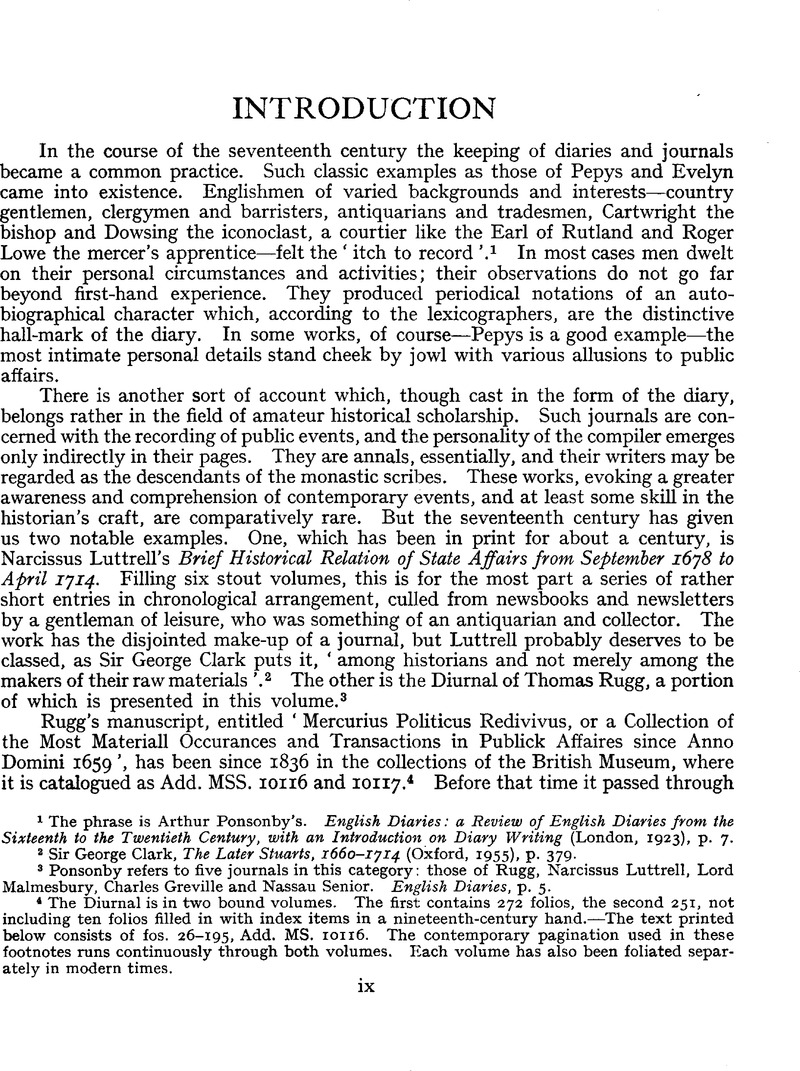No CrossRef data available.
Article contents
Introduction
Published online by Cambridge University Press: 24 December 2009
Abstract

- Type
- Introduction
- Information
- Copyright
- Copyright © Royal Historical Society 1961
References
page ix note 1 The phrase is Ponsonby's, Arthur. English Diaries: a Review of English Diaries from the Sixteenth to the Twentieth Century, with an Introduction on Diary Writing (London, 1923), p. 7.Google Scholar
page ix note 2 SirClark, George, The Later Stuarts, 1660–1714 (Oxford, 1955), p. 379.Google Scholar
page ix note 3 Ponsonby refers to five journals in this category: those of Rugg, Narcissus Luttrell, Lord Malmesbury, Charles Greville and Nassau Senior. English Diaries, p. 5.
page ix note 4 The Diurnal is in two bound volumes. The first contains 272 folios, the second 251, not including ten folios filled in with index items in a nineteenth-century hand.—The text printed below consists of fos. 26–195, Add. MS. 10116. The contemporary pagination used in these footnotes runs continuously through both volumes. Each volume has also been foliated separately in modern times.
page x note 1 I use the spelling, ‘ Rugg ’, as the diarist did in his will; this is also the case in the registers of St. Paul's, Covent Garden. On Rugg's family connexions the Diurnal has no clues, except a reference to a Thomas Lewger as a brother (see below, p. 88). Walter Rye suggested that the diarist may have been Thomas Rugg of Felmingham, who in 1608 married Bridget Pennell, or Thomas Rugg who in 1666 mortgaged Northrepps and Hardingham to the Lord Mayor of London, and who died without issue. Neither can be accepted, since we know that Rugg left children and that his will makes no mention of real property. Norfolk Families (Norwich, 1911–13), p. 757Google ScholarPubMed.
page x note 2 Below, p. 154.
page x note 3 Hunt, William H., ed., The Registers of St. Paul's Church, Covent Garden, London (Harleian Society Publications), vol. i (London, 1906), pp. 1 ff.Google Scholar
page x note 4 ‘ Septimiae february 1670/1 Thoma Rugg filius Thomae Rugg nuper parochiae de St. Paul Covent Garden in Comitatu Middx barber defuncti posuit se apprenticem Petro Smith pro septem annis a die dato.’ Apprentice Binding Book, 1657–72, Guildhall Library MS. 5266/1, p. 189. A William Rugg was admitted freeman of the Barber Surgeons' Company in 1641. Freedom Admissions, 1522–1664, MS. 5265/1, fo. 96r.
page x note 5 Glencross, Reginald M., ed., Calendar of the Marriage Licence Allegations in the Registry of the Bishop of London, vol. ii, 1660–1700 (Index Library, British Record Society, lxvi, 1940), p. 9Google Scholar.
page x note 6 The will speaks of ‘ her way of trade ’, but gives no particulars.
page xi note 1 Below, pp. 165, 167.
page xi note 2 P.C.C. 40 Penn.
page xi note 3 Below, p. 1.
page xii note 1 Rugg Diurnal MS., p. 531 (misnumbered 431).
page xii note 2 MS., p. 748.
page xii note 3 Below, p. 1.
page xii note 4 Below, p. 6.
page xii note 5 Rugg does not date the making of an entry. His dates refer to the events he is chronicling. In this respect he is by no means systematic or precise, for as often as not he contents himself with a mere ‘ then ’ or ‘ at this time ’. Occasionally he inserts dates in the margins.
page xiii note 1 Below, p. 2.
page xiii note 2 Below, p. 89.
page xiii note 3 Examples are Charles's return to London and the ceremonial creation of Knights of the Bath; see below, pp. 88–90, 167–69.
page xiii note 4 MS., p. 232.
page xiv note 1 MS., pp. 235, 285, 439.
page xiv note 2 Below, pp. 66–67.
page xiv note 3 MS., p. 250.
page xiv note 4 Below, p. 142.
page xiv note 5 Below, p. 95.
page xiv note 6 Below, pp. 64, 65.
page xvii note 1 Below, pp. 23, 108.
page xvii note 2 Below, pp. 40, 53.
page xvii note 3 Below, p. 62.
page xvii note 4 Below, p. 87.
page xvii note 5 MS., pp. 296, 394.
page xvii note 6 Below, p. 151; MS., p. 213.
page xviii note 1 Muddiman, J. G., The King's Journalist, 1659–1689 (London, 1923), p. 163Google Scholar.
page xviii note 2 Below, p. 48.
page xviii note 3 Below, p. 142.
page xviii note 4 Below, p. 154.
page xviii note 5 MS., p. 376.
page xviii note 6 Below, p. 18.
page xviii note 7 MS., p. 646.
page xviii note 8 MS., p. 597.
page xviii note 9 MS., pp. 511, 575, 616.
page xviii note 10 MS., p. 235.
page xix note 1 Below, p. 51.
page xix note 2 MS., p. 461.
page xix note 3 Below, pp. 16, 51.
page xix note 4 Below, p. 27.
page xix note 5 MS., p. 594.
page xix note 6 Below, p. 26.
page xix note 7 Below, pp. 108–09.


